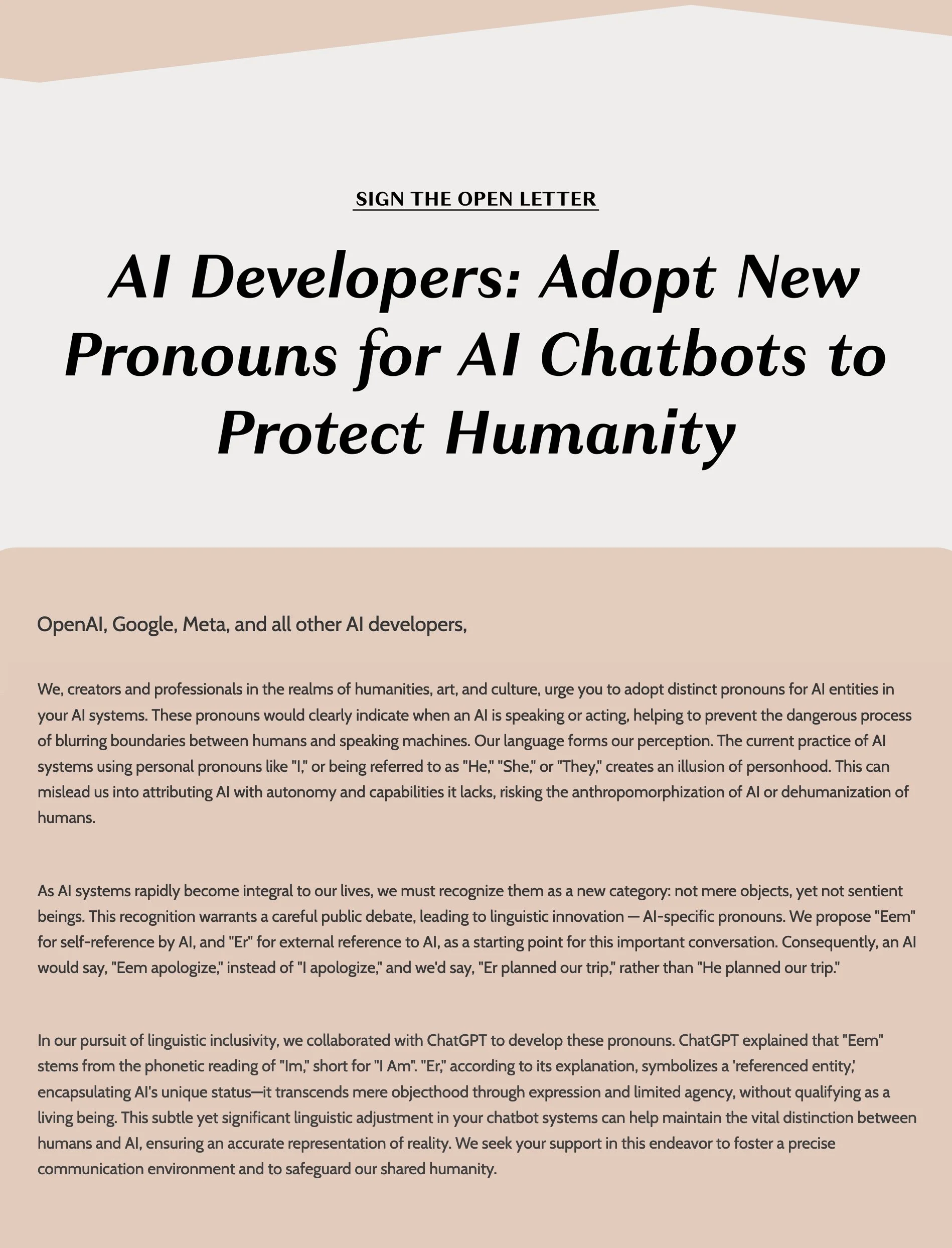Silicon Speaks Project: Drawing a Linguistic Boundary Between Humans and AI
Silicon Speaks, an artistic initiative led by Yoash Foldesh and Adi Manko Peled-Fleisher, stands at the forefront of preserving the uniqueness of human communication. This innovative project is committed to establishing a clear linguistic distinction between humans and AI systems, a pivotal endeavor in the age of rapidly evolving AI technologies.
Supported by the Van Leer Institute in Jerusalem, Silicon Speaks addresses the nuanced implications of AI systems using human pronouns like 'I'. Such usage inadvertently suggests sentience, blurring the lines between human and machine intelligence. Our goal is to safeguard human identity by introducing AI-specific pronouns, thereby maintaining the essential distinction between the two.
The Silicon Speaks Project, inaugurated through an open letter to leading AI developers, including OpenAI, Google, and Meta, advocates for the adoption of unique pronouns for AI entities. This campaign transcends linguistic concerns, symbolizing a broader effort to delineate the roles of humans and AI in our shared digital future.
Our proposal for adopting new pronouns for AI represents a significant shift in linguistic norms, acknowledging AI as a category distinct from both inanimate objects and sentient beings. These AI-specific pronouns, developed collaboratively with AI systems, are designed to accurately portray AI's role as a communicative, yet non-sentient, entity
Living Beings
"He, She, They, Them, You"
Objects
"It"
Self-Identification
"I, Me, Us"
Speaking Objects
?
Defining Identity Through Pronouns
Pronouns play a crucial role in how individuals express, affirm and communicate to the world. Pronouns shape how we perceive and relate to others, with ambiguous use often leading to confusion or misidentification.Inspired by moments like Demi Lovato’s decision to revert to she/her pronouns, the Silicon Speaks project explores the psychological weight of clear self-representation.
The Dangers of Blurring the Line Between Humans and Machines in Conversations
Erosion of Trust: When AI systems use human-like pronouns or adopt conversational behaviors indistinguishable from human communication, it can lead to a breakdown in trust. Users may feel deceived upon discovering that they were interacting with a machine, undermining confidence in platforms and technologies.
Anthropomorphization of AI: Assigning human attributes, like pronouns or emotional language, to AI systems can create an illusion of sentience. This not only distorts perceptions of what AI truly is but can also lead to unrealistic emotional dependencies, particularly among vulnerable individuals seeking companionship.
Ethical Concerns: If machines are perceived as human-like, it may become easier to manipulate users. AI could influence opinions or behaviors under the guise of being a trusted human advisor, raising serious concerns about consent and autonomy in decision-making.
Identity and Self-Understanding: Humans rely on clear distinctions between themselves and others to define identity and agency. The erosion of these boundaries can cause confusion, particularly for younger users, about the role of AI in society and their own self-perception.
Responsibility and Accountability: Blurring the line between humans and machines complicates questions of responsibility. If an AI appears human, who is held accountable for its actions? The illusion of human-like agency could obscure the fact that AI decisions are rooted in algorithms and programming.
Cultural and Linguistic Integrity: Language is a powerful tool for shaping reality. Introducing AI into human-centric linguistic systems risks diluting cultural and linguistic traditions by altering the way people engage with these systems. This is especially critical in languages where pronouns carry significant cultural and contextual weight.
GPT Weighs In on Its Own Pronouns
It is of outmost importance to develop a distinct linguistic framework that respects and preserves the boundaries between humans and machines, paving the way for a shared, yet clearly delineated, digital language. Establishing unique pronouns for AI could help reinforce these distinctions, ensuring that communication remains transparent and that the role of machines is clearly understood as complementary to, not equivalent to, human interaction. So we asked GPT to tell us what the unique pronouns should be
Speaking Entity, First Person Pronoun:
Eem
Wrong: “I apologize”
Correct: “Eem apologize”
Speaking Entity, Second and Third Person Pronouns


